Butterflies and Moths
Media

Species Types
Scientific Name
Megalographa biloba (formerly Autographa biloba)
Description
The bilobed looper moth has a conspicuous B-shaped silvery spot on each forewing. Caterpillars of this noctuid moth eat a wide range of plants, and this species is widespread.
Media

Species Types
Scientific Name
More than 12,000 species in North America north of Mexico
Description
Learn about moths as a group. What makes a moth a moth? How are moths different from butterflies? What are the major groups of moths?
Media
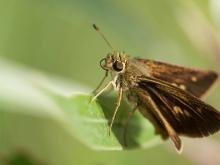
Species Types
Scientific Name
About 275 species in North America north of Mexico
Description
At first glance, skippers look halfway between butterflies and moths. They are commonly seen darting among the flowers they visit on hot summer days.
Media

Species Types
Scientific Name
More than 700 species in North America north of Mexico
Description
Learn about butterflies and skippers as a group. What makes a butterfly a butterfly? How are they different from moths? What are the major groups of butterflies?
Media

Species Types
Scientific Name
Phyciodes tharos
Description
Don't let the pearl crescent’s dainty size keep you from admiring its intricate beauty.
Media

Species Types
Scientific Name
Polygonia comma
Description
The eastern comma is named for a small white mark on the underside of the hindwing. It flies spring through fall, and even in winter, on warm, sunny days.
Media
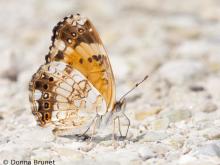
Species Types
Scientific Name
Chlosyne nycteis
Description
Black and orange above, paler below, the silvery checkerspot has a telltale wide white crescent in a brownish patch along the edge of the hindwing underside.
Media
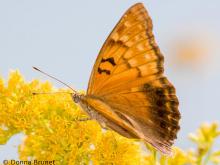
Species Types
Scientific Name
Asterocampa clyton
Description
The tawny emperor is less common than the hackberry emperor and has a rustier coloration. Both species feed on hackberry trees as caterpillars.
Media
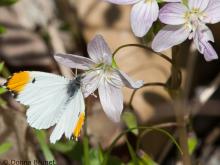
Species Types
Scientific Name
Anthocharis midea
Description
Falcate orangetip males are unmistakable with their small size, white coloration, and orange wingtips. Look for them in open woodlands in April.
Media
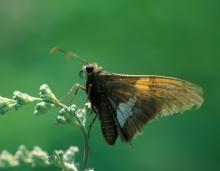
Species Types
Scientific Name
Epargyreus clarus
Description
In a large, global family of several thousand species, the silver-spotted skipper is one of the easiest to identify in our state.
See Also


Media

Species Types
Scientific Name
About 1,500 species in North America north of Mexico
Description
Adult caddisflies are mothlike. Their larvae are aquatic and build portable, protective cases out of local materials, including grains of sand, bits of leaves and twigs, and other debris.
Media

Species Types
Scientific Name
Corydalus cornutus
Description
Adult eastern dobsonflies are huge and mothlike, with large wings and a weak, fluttery flight. The fiercely predaceous aquatic larvae, called hellgrammites, are well-known to anglers, who often use them as bait.
About Butterflies and Moths in Missouri
Butterflies, skippers, and moths belong to an insect order called the Lepidoptera — the "scale-winged" insects. These living jewels have tiny, overlapping scales that cover their wings like shingles. The scales, whether muted or colorful, seem dusty if they rub off on your fingers. Many butterflies and moths are associated with particular types of food plants, which their caterpillars must eat in order to survive.





















